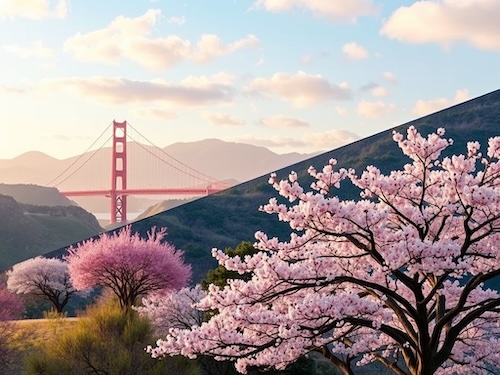Migrant Energy Powers California GDP Past Japan's
By Tom Kagy | 27 Apr, 2025
The Golden State is economically bigger than Japan, and its citizens 3 Times richer.
California's $4.1 trillion GDP for 2024 edged out Japan's $4.02 trillion to make the Golden State, with a mere 14% of the US population, the world's 4th largest economy.
That means California's 39.4 million diversely tanned individuals outproduced Japan's homogenous society of 123 million people on a nominal dollar-denominated basis. From a purely quantitative perspective that's a stunning disparity in productivity, and more importantly, prosperity. California's median household income of $95,500 puts to shame Japan's $35,792 (estimate based on per capita household income multiplied by average household size).
We aren't making some lame comparison between the biggest state of the Union and some backward 3rd-world nation. Japan has long been seen as a model of an ultra-productive advanced industrial society which, during much of the 1980s, was seen as a challenger to US economic and even cultural dominance.
Japan is a powerhouse nation full of manufacturing giants like Toyota, Mitsubishi Heavy, Daikin, Honda, Sony, Komatsu, Hitachi and a long list of others. And it's not as though Japan is a tiny parcel of land like Singapore with zero natural resources. Japan's land area is 93.6% that of California's, with a higher percentage of useable land area due to California's vast deserts and rugged mountains.
Japan has long prided itself on having a homogenous population enjoying unmatched social stability and a 99% literacy rate — precisely the kind of society held up as an ideal by the ultra-nationalistic regime currently in the White House.
To put the finishing touches on the picture of Japan as the ultimate model of a MAGA-style nation, it's one of the world's most closed economies, with a daunting array of protectionist laws, tariffs and regulations designed to keep out migrants and foreign businesses and products while preserving to a pathological degree an agrarian culture and political system from pre-industrial days.
This obsession with preservation over progress is costing the Japanese people a high price — household income per-capita that's about 23% lower than that of South Korea, Japan's onetime colony. And the future looks dimmer for Japan. Its per capita income has been sliding steadily from $20,782 in 2020 to $15,562 in 2024.
By comparison the 2024 household income per capita for California is $47,977, the US as a whole $40,222, Singapore $38,977, UK $34,805, Germany $33,632, France $28,072, Qatar $24,999, S. Korea $19,209, Taiwan $16,606, Malaysia $5,732, China $4,806 and Mexico $3,690.
California's foreign-born population of 27.3%, the nation's highest, is shining proof that the quintessential American model of an open liberal democracy welcoming of immigrants produces a more economically dynamic society than a protectionist nation closed to migrants and foreign goods and enterprises.
We don't have to look outside the US to see that a high migrant population makes for a prosperous, dynamic economy. California's income rank is 5th among states. New Jersey, with the second highest immigrant percentage at 24.2%, ranks 2nd in income. First in income is Massachusetts with an 18% immigrant percentage, the nation's 6th highest.
By contrast the lowest income states have the lowest immigration rates. West Virginia, the state with by far the lowest foreign-born rate at 1.8%, is the nation's 2nd poorest, just behind Mississippi, with a 2.6% immigrant percentage. The 2nd lowest foreign-born rate is Montana at 2.2%. The state's a bit of an outlier, being the 16th poorest (helped by a boom in oil and gas activity). Louisiana, the 3rd poorest state, has the 11th lowest immigrant rate at 4.9%.
Looking ahead, states with the high foreign-born percentages tended to enjoy the strongest income growth over the past decade. California's 4.73% income growth rate over the past decade is the nation's 4th highest. The highest growth rate is enjoyed by Washington state which has a 15.5% immigrant percentage, the 10th highest. Nevada, with a 19.2% foreign-born rate, the nation's 4th highest, has a 4.07% income growth rate, the 20th highest.
By contrast the growth rates for West Virginia, Mississippi and Louisiana are, respectively, 3.09% (47th), 3.63% (34th) and 2.80 (48th). Alaska, the state with the lowest growth rate, has a 7.4% immigrant population, the nation's 26th highest. Wyoming, the 2nd slowest income grower at 2.11%, has a 3.6% immigrant percentage, the 3rd lowest.
It's worth noting that even California's native-born population is largely the offspring of recent immigrants. That makes virtually the entire population restless with the relentless drive and energy that built America's growth and innovation engine from little more than desert and dreams of unlimited wealth.
The destruction of California's brand of creative and productive energy would be the inevitable result of imposing the kind of barriers that have made Japan a poster child for the folly of protectionism.
That makes virtually the entire population restless with the relentless drive and energy that built America's growth and innovation engine from little more than desert and dreams of unlimited wealth.

Asian American Success Stories
- The 130 Most Inspiring Asian Americans of All Time
- 12 Most Brilliant Asian Americans
- Greatest Asian American War Heroes
- Asian American Digital Pioneers
- New Asian American Imagemakers
- Asian American Innovators
- The 20 Most Inspiring Asian Sports Stars
- 5 Most Daring Asian Americans
- Surprising Superstars
- TV’s Hottest Asians
- 100 Greatest Asian American Entrepreneurs
- Asian American Wonder Women
- Greatest Asian American Rags-to-Riches Stories
- Notable Asian American Professionals

